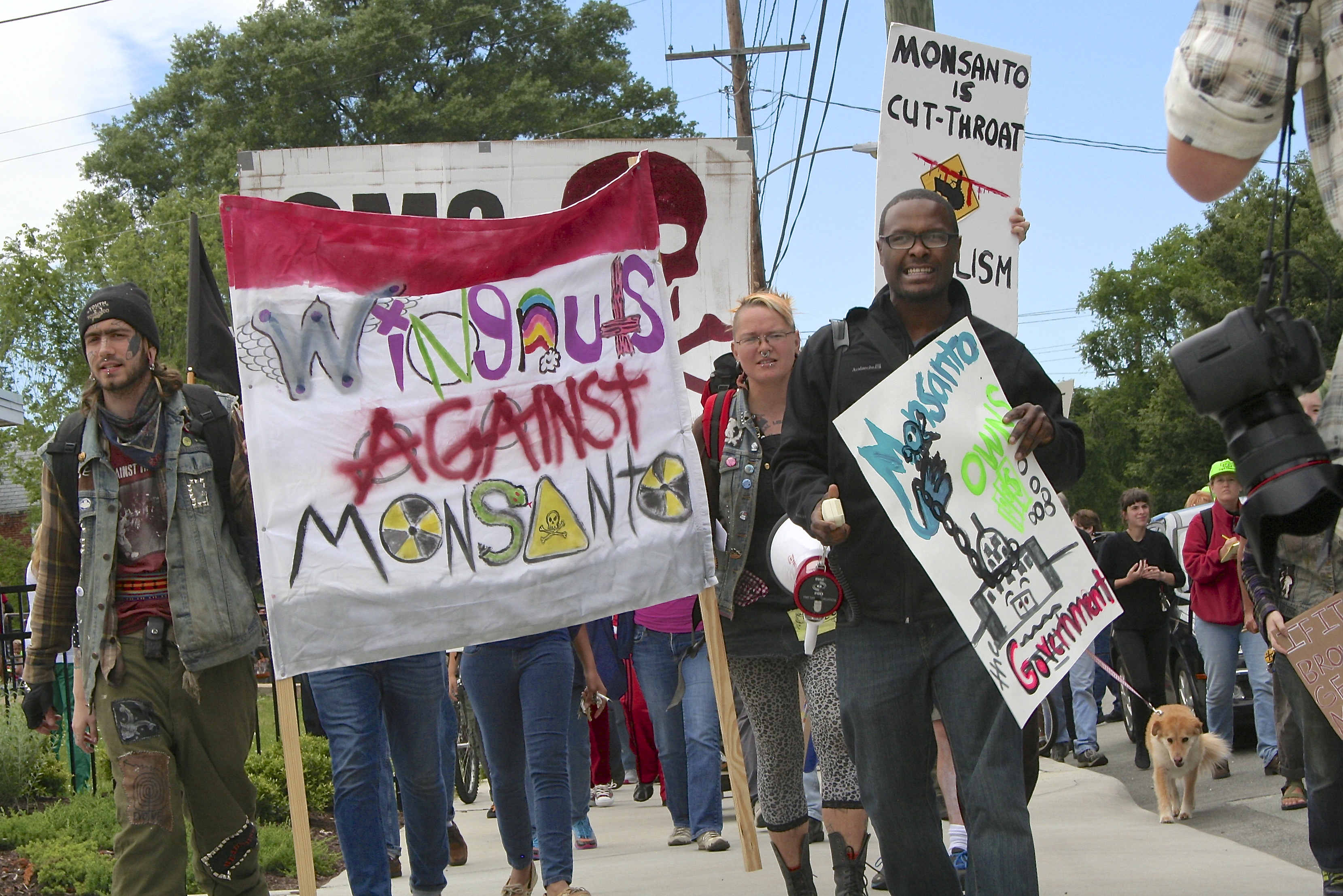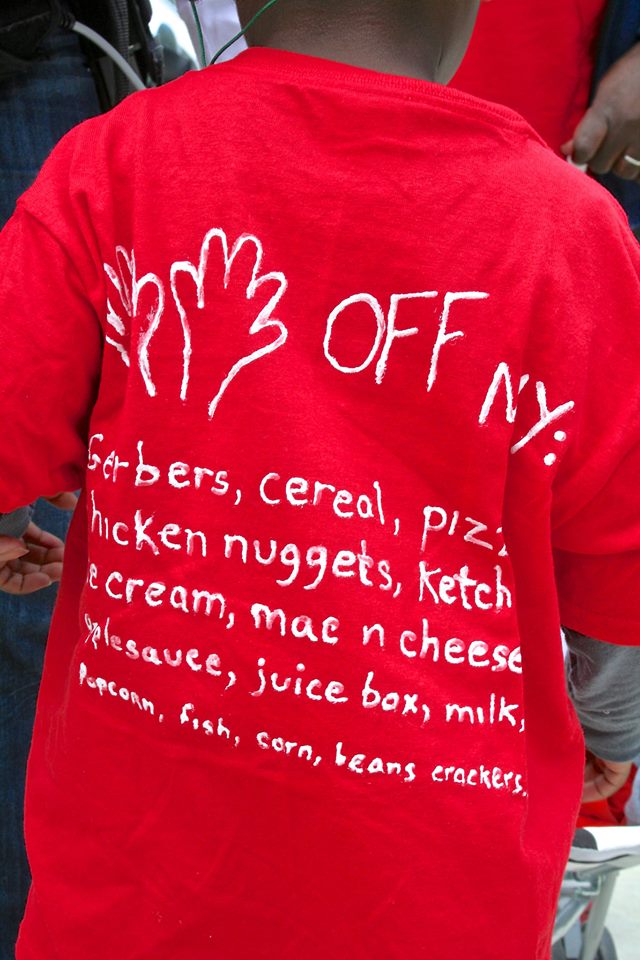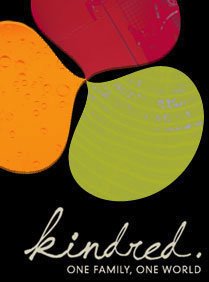Food Revolution Allies: In An “Unprecedented Uprising” Moms and Anarchists Unite in March Against Monsanto
About the March Against Monsanto
Revolution makes for strange bedfellows, especially when we’re talking about an issue that affects every person on the planet: food. Officially recognized for little over a decade in a book by the same name, the Food Revolution is creating bonds and building community across socio-political-economic strata and philosophy. In a rare and encapsulated, local view of the worldwide Food Revolution, the article below illuminates one of 436 organized, global marches on May 25, 2013, where mothers, anarchists, community organizers and local food supporters joined hands to protest the biotech giant Monsanto’s monopolization of the global food supply. In providing the context and importance of the local revolutionary march, the article presents interviews with Tami Monroe Canal, March Against Monsanto founder, and Jeffrey Smith, the world’s foremost nonGMO consumer advocate on “the unprecedented global uprising” of the first global march in 53 countries with two million protesters. See more photos of the Richmond march here. Watch a video featuring the pre-march rally and speech at the end of this article.
Moms and Anarchists Unite in March Against Monsanto To Become Food Revolution Allies
By Lisa Reagan
|
“What I told the Denver marchers is that we are now winning. NonGMO sales were up 26% last year and 26 states are introducing labeling laws. This year we saw Whole Foods say they are labeling GMOs by 2018. Currently, when a product becomes nonGMO verified it increases sales by 30%. Another sign of the tipping point came today when the New York Times said that many companies are scrabbling for a nonGMO options because of consumer demand. We also think there will be a tipping point against animal products that are fed GMOs, like milk and eggs.” — Jeffrey Smith, from the Institute for Responsible Technology, in an interview below. |
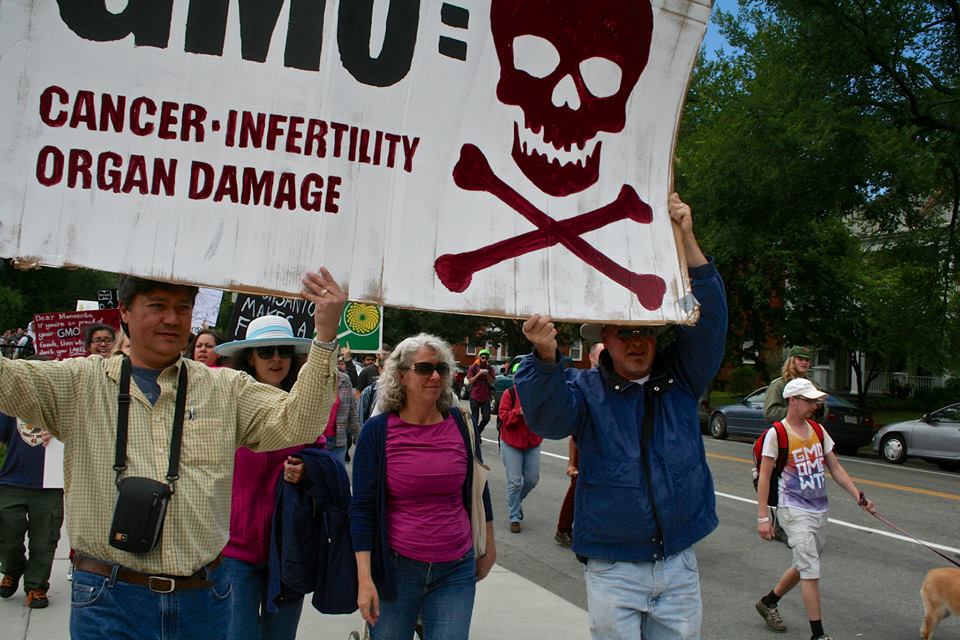
Except for a smattering of skull and crossbones on posters, the May 25th March Against Monsanto in Richmond, Virginia, appeared to be a small town, picturesque Fourth of July parade complete with babies in strollers, children banging pots with soup spoons, and a pumped crowd cheering to a passionate speech advocating the perennial need to defend democracy and perform the duties of citizenship.
But the messages on homemade posters were clear: this peaceful and socially diverse gathering intended to demonstrate their collective rage at a biotech giant and stage an ongoing and well-organized revolution. “Today,” as march organizer, John Lewis, pronounced through a bullhorn, “is just the beginning.”
In the parking lot of a US Post Office, adults and students, who normally wouldn’t move in the same social circles, met each other warmly for the first time over the common cause of their food supply. While seasoned activists like the Wing Nuts’ anarchist group protected the march participants from harassment, foodies shared markers to make their signs, and moms and dads held onto dogs and babies, new activists were born as children sported t-shirts proclaiming, “I am not your science experiment.”
In a worldwide march whose wildfire success no one predicted, the 350 Richmonders joined two million people in 53 countries and 436 cities to protest the infiltration of the world food supply by genetically-engineered organisms, GMOs, and to demonstrate their commitment to championing a GMO-free Food Revolution.
In hindsight, the fury of Saturday’s global march erupted after years of building frustration by voting and educated citizens whose questions about the health and environmental risks of GMOs have been repeatedly dismissed by government, corporations and media. In the United States, a 2008 CBS News Poll found that 87% of consumers want GMOs labeled and a CBS/New York Times poll found that 53% of US consumers said they would not buy food that has been genetically modified. (Source)
In defiance of American public will and outright collusion of government and corporate interests this spring, the sneaking of a biotech rider, dubbed the Monsanto Protection Act, into a “must pass” bill prompted Daily Show host, Jon Stewart, to mock the audacity of the rider in a segment called, “You Stuck What Where Now?”
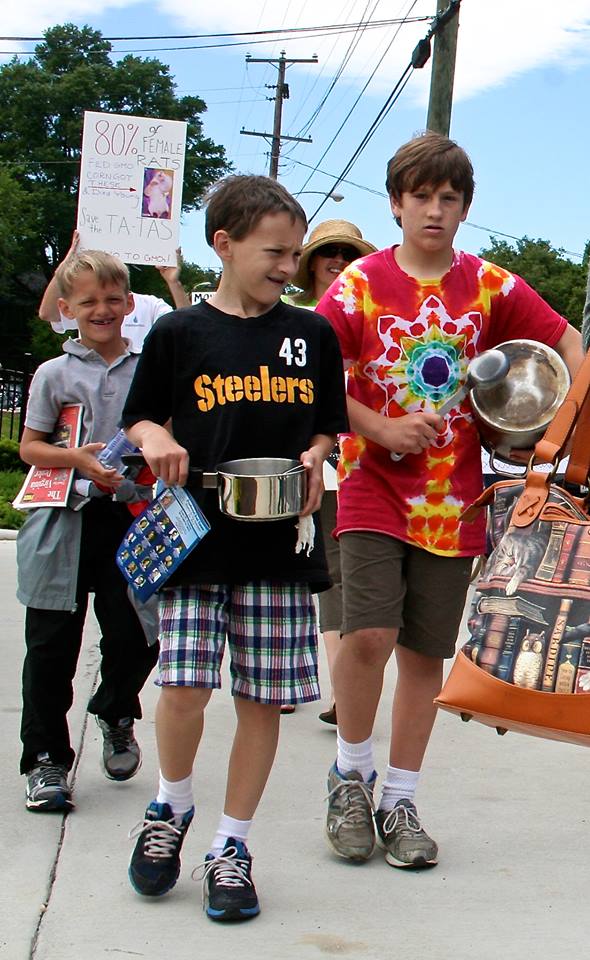
And just days before the May 25th march, the US Senate voted down a bill for GMO labeling. While most countries do label GMOs, the United States does not. Sponsor Senator Bernie Sanders quipped, “What we’re talking about today is a fairly commonsense and non-radical idea.”
It was the Proposition 37 defeat in California last year that prompted fed-up Utah mom, Tami Monroe Canal, to post a Facebook page on February 28, 2013 asking people to join her in a march against biotech giant Monsanto and its unwanted GMO products in less than three months.
“I did this because I was living in California when Prop 37 didn’t pass and I was horrified,” Canal told Kindred. “I kept getting angrier and angrier and thought we’ve got to help spread the word. So I started the March Against Monsanto page. I thought if I got 3,000 people to march in the streets, that would be great.”
Her outrage at not being able to make informed choices for her six year-old daughter and 18 month-old baby quickly turned into a world-class and efficiently organized protest machine with the help of a diversity of international volunteer groups, from mom’s groups to anarchists. “People put aside their differences and came together,” said Canal.
From the beginning, says Canal, March Against Monsanto, MAM, was to be nonviolent, however, “Prior to the march our Facebook page was being tampered with and trolls were trying to get people riled up. Our whole message along the way was to be peaceful and take the high road because we know we’re right.”
International Protesters Share Their Reasons
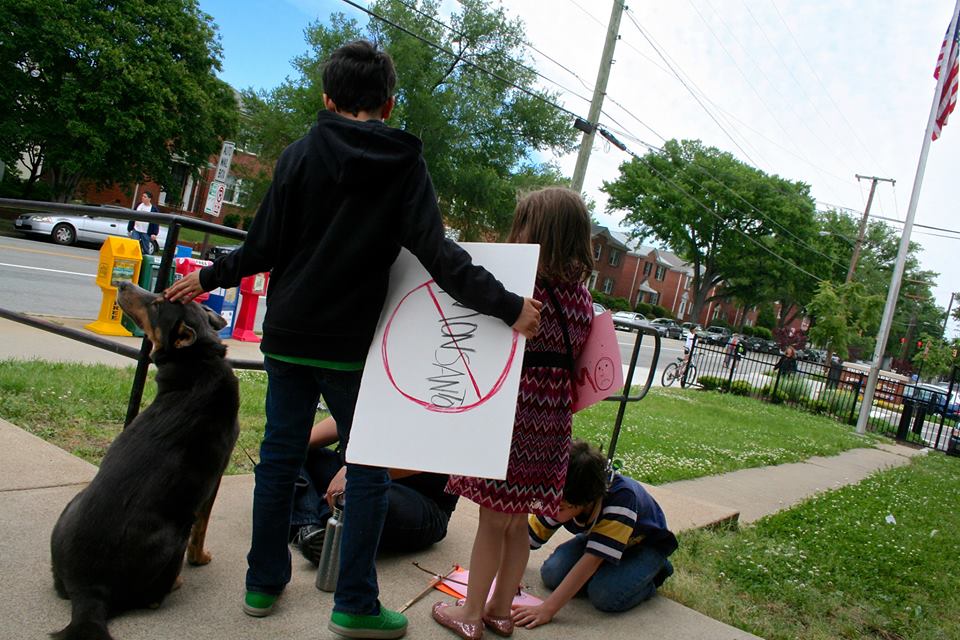
US citizens were not the only ones enraged over their democratic process being hijacked to protect Monsanto and keep them blind to the origins of their food. Other international citizens shared their motivation for joining the march on MAM’s website:
An organizer in Athens, Greece, Roberta Gogos, spoke about the importance of the events in austerity-impacted South Europe. “Monsanto is working very hard to overturn EU regulation on obligatory labeling (questionable whether it’s really enforced in any case), and no doubt they will have their way in the end. Greece is in a precarious position right now, and Greece’s farmers falling prey to the petrochemical giant is a very real possibility.”
Josh Castro, organizer for Quito, said he wants to protect Ecuador against Monsanto’s influence, too. “Ecuador is such a beautiful place, with the richest biodiversity in the world. We will not allow this Garden of Eden to be compromised by evil multinational corporations like Monsanto. Biotechnology is not the solution to world hunger. Agroecology is.”
Monsanto CEO, Hugh Grant, responded by saying to Bloomberg earlier in May that critics of his company “are fueling anti-GMO sentiment by capitalizing on an increased public interest in how their food is produced and pushing that agenda through social media sites, such as Facebook and Twitter” and that they are “ruining the opportunity to feed the world using technological advances.”
As many protesters’ signs asked, “Monsanto, if you’re so proud of your GMO products, then why don’t you label it?”
Jeffrey Smith: “An Unprecedented Uprising”
In an interview with Kindred, Jeffrey Smith, considered the world’s foremost nonGMO consumer advocate, pointed out the significance of the global March Against Monsanto. “This is two million people in countries around the world and is illustrative of an unprecedented upsurge against GMOs and Monsanto. So the word is out now. The general consensus among those that are informed is outrage.
“This is a people’s uprising against the corporate takeover of their food supply. Monsanto paid Arthur Anderson to help them corner the food supply years ago. They are now looking at doing this with insects and animals to replace nature with their designer, patented organisms. This has never been foisted upon humanity and nature. It is appropriate that there is a collective world-wide resistance.”
Smith, who is the founder of the Institute for Responsible Technology and producer of the new documentary, Genetic Roulette: The Gamble of Our Lives, spoke at the March Against Monsanto event in Denver, Colorado.
“What I told the Denver marchers is that we are now winning. NonGMO sales were up 26% last year and 26 states are introducing labeling laws. This year we saw Whole Foods say they are labeling GMOs by 2018. Currently, when a product becomes nonGMO verified it increases sales by 30%.
“Another sign of the tipping point came today when the New York Times said that many companies are scrabbling for a nonGMO options because of consumer demand. We also think there will be a tipping point against animal products that are fed GMOs, like milk and eggs.”
Smith is the author of the books, Seeds of Deception: Exposing Industry and Government Lies about the Safety of the Genetically Engineered Foods You’re Eating and Genetic Roulette: The Documented Health Risks of Genetically Engineered Foods.
Delayed Media Coverage
Even though the May 25th march attracted two million protesters worldwide, activists noticed a considerable delay in coverage over the weekend. However, by Memorial Day Monday in the US, Google showed over 68,000,000 posts on the event.
“The coverage is now starting because the mainstream media cannot ignore this any longer,” said Smith. “They are starting to cover the issue but they are thin and superficial in their coverage. They interview me and what they put on the air ends up being ridiculously superficial. We are seeing unprecedented coverage but not the kind of coverage that is worthy of the real news.”
The Common Denominator: Food
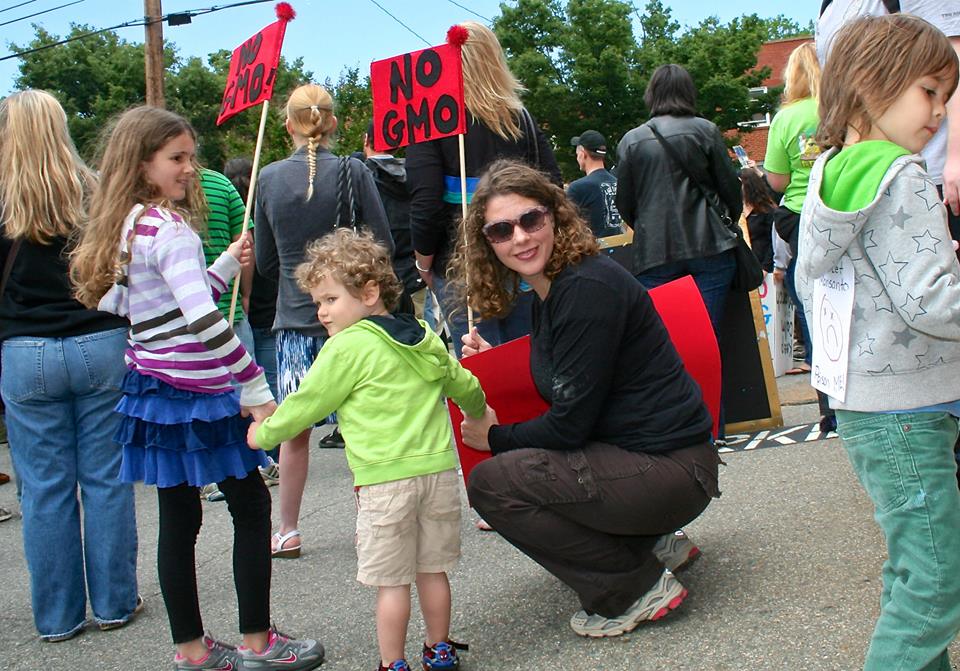
Canal said she knew from talking with marchers around the world that people from diverse backgrounds, who normally don’t socialize with one another, were inspired to come together to protect their children and their food supply. “Anarchists were really helpful internationally,” said Canal. “Anarchists and Christians marched together at these events.”
Many events featured children marching with their families. “Facebook has been reported to be censoring photos of children carrying signs,” said Canal, reference an online story of one mom having her Facebook page shut down after posting photos of her children participating in a local MAM. “But they are going to be the first generation that is brought up primarily consuming GMOs and pesticides. Dr. Don Huber, who is an expert in GMO foods, has said that this generation is the sacrificial lamb. The five A’s are all on the rise in our children: allergies, autism, asthma, Aspergers, and ADHD. Usually we have cancer cells across the country, like contaminated ground water, but when we see these kinds of diseases on the rise internationally we have to look to our common denominator and that is our food.”
In Richmond, Virginia, Kate Noon says she brought her children to the march because she believes, “food justice is an issue that even young children can relate to in terms of the basic concept of growing, buying and eating healthy foods.
“I want to raise my children with the understanding of social justice and the belief that through public protest they can engage dynamically with society to raise awareness and enact positive changes in our world,” said Noon. “I want them to know that they have a voice and to experience empowerment. Compared with some of the other protests I attend, March Against Monsanto was a more family-oriented, low-risk opportunity for social activism.”
The Richmond march appeared low-risk and well-organized due to a few experienced protest coordinators from an officially accredited anarchist group, Wingnut. In this regard, the Richmond march reflected Canal’s observation of other international marches where anarchists helped uninitiated groups stage their protests. The Richmond march sported bike marshals to protect the edges of the parade, legal observers wearing day-glo baseball caps – who were students from the University of Richmond and members of the National Lawyers Guild – and “cop watchers” who were trained to understand and protect first amendment rights to protest.
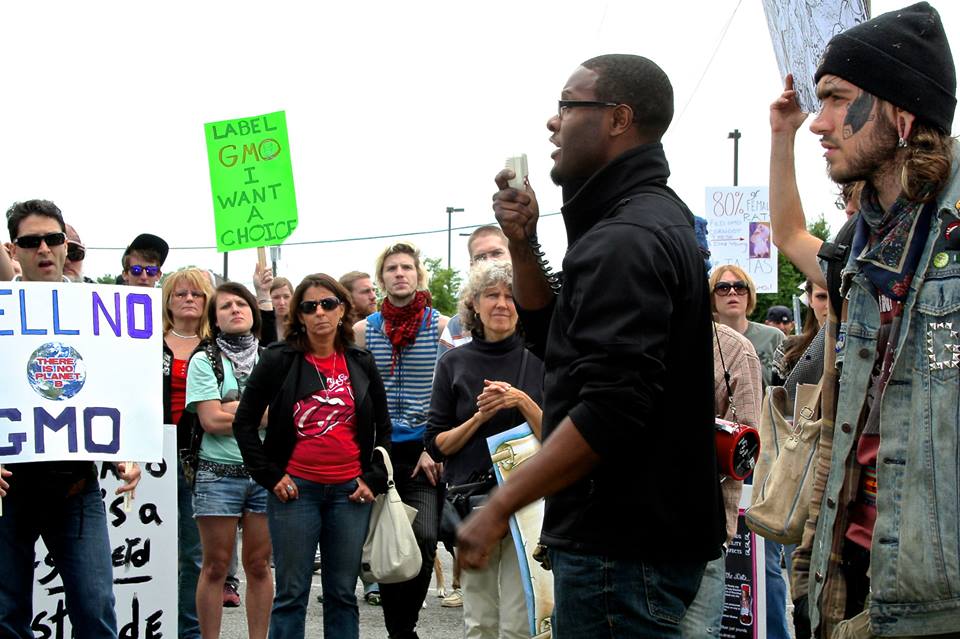
Nicko Adams, a participant in the Wingnut collective, shared that he wasn’t sure if the “socio-normative” people like Kate and her family would think he “was a crazy convict.” (See Nicko in the photo on left)
Adams explained that, “Wingnut is not interested in capitalism as humanity’s dominate means of life because it doesn’t work for a lot of people. Marginalization of people is a necessary factor of capitalism. Feudalism has been switched over to capitalism. We are interested in getting rid of the capitalistic part of agriculture.”
Noon responded to Adam’s worry that his appearance would startle her children by saying, “Funny, my kids were actually more interested in the dogs and the chicken at the march than the other people. And my son liked the bike marshalls… and the police. They have grown up in Richmond, and at this point I think they are desensitized to tattoos, piercings, brightly colored hair, etc. I think the diversity of this movement is such a positive factor!”
“I thought the event went off surprising well given how many new faces there were. There seemed to be a lot of people who had never participated in that sort of event before, people who walked with people who knew how to protect them in getting out their message,” said Mo Karnage, also a Wingnut member. “Unfortunately there is more than just one issue that we need to build a revolutionary movement around considering the varieties of oppression that are continuing around the world.”
Local farmers market owners, organic farming supporters, concerned “socio-normative” parents and activists from organizations like Renew Richmond all found themselves among new allies after Saturday’s march.
John Lewis, of Renew Richmond, says the march on Saturday was just the beginning. “We will continue to show in strong force that we will not stand for Monsanto’s immoral actions. This is not our first and final message, this is a catalyst for discussion and to gather people together who are now fired up. Renew Richmond will work with other groups to teach people how to boycott Monsanto, grow their own food and find local food sources.”
The Food Revolution Going Forward
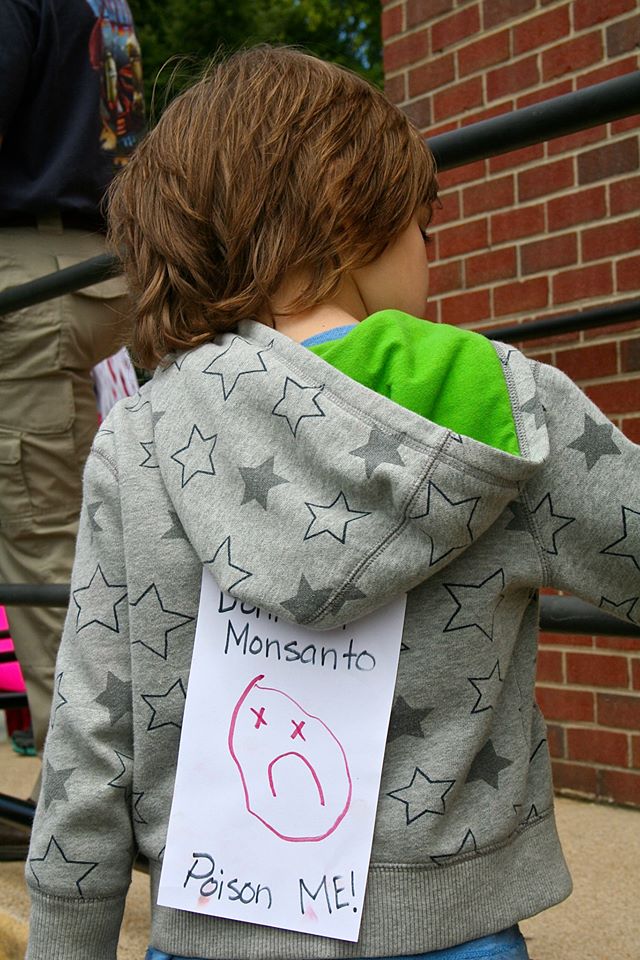 Both international organizer, Canal, and local activists noted the diversity of groups and individuals and agreed this diversity will be their strength going forward. Global and local marchers promised that while May 25, 2013 was one day of marching against something, going forward and for the other 364 days of the year, their actions as activists will be for the protection and promotion of their local and global food supply.
Both international organizer, Canal, and local activists noted the diversity of groups and individuals and agreed this diversity will be their strength going forward. Global and local marchers promised that while May 25, 2013 was one day of marching against something, going forward and for the other 364 days of the year, their actions as activists will be for the protection and promotion of their local and global food supply.
But the truth is, if moms and anarchists have officially united against Monsanto, shouldn’t the bullying, bio-tech giant call it a day?
Richmond mom, Kate Noon says she will continue teaching her children about their food choices. “Involving children in the growing, buying, and preparation of food is a great way to talk about food safety and nutrition on a daily basis,” said Noon. “Using the Buycott phone app has led to conversations with my daughter not only about why we make certain choices about which foods to buy, but also why we now choose to buy from or not buy from certain companies based upon their support or non-support of a safe and transparent food industry.”
“We have to use our voices now before our children grow up,” Canal said. “It will be too late then. We cannot wait for someone to step up. We are those people. We have to insure our future for our children.”
Canal invites everyone to join the next two opportunities for activism, listed below. For photos of international marches, visit March Against Monsanto on Facebook.
To find out more about March Against Monsanto in Richmond, Virginia and their upcoming group collaborations, visit them here.
Please visit Jeffery Smith at the Institute for Responsible Technology for extensive resources to support your informed food choices, including a NonGMO Shopping Guide.
All Photos by Lisa Reagan. See all event photos at Kindred on Facebook.
Listen to the March’s Rally Speech and See Photos of the Event
March Against Monsanto, Richmond, Virginia from Kindred Magazine on Vimeo.
![Kindred]() RESOURCES
RESOURCES
Check out Kindred’s Bookstore for Growing Your Own Food and Whole and Local Food Cookbooks.
SHOPPING GUIDES
Eat Well Guide
If you want good meat and don’t want the problems associated with industrially-raised factory meat, the Eat Well Guide is for you. This online resource lists farms and stores that sell sustainably-raised meat, including organic, antibiotic and hormone free, humanely raised, pasture raised and pasture raised. (Restaurants will be coming shortly.) This comprehensive guide covers all 50 states and Canada, and includes beef, pork, chicken, turkey, fish, lamb, goat, dairy and eggs. This is “the” resource for sustainably-raised meat.
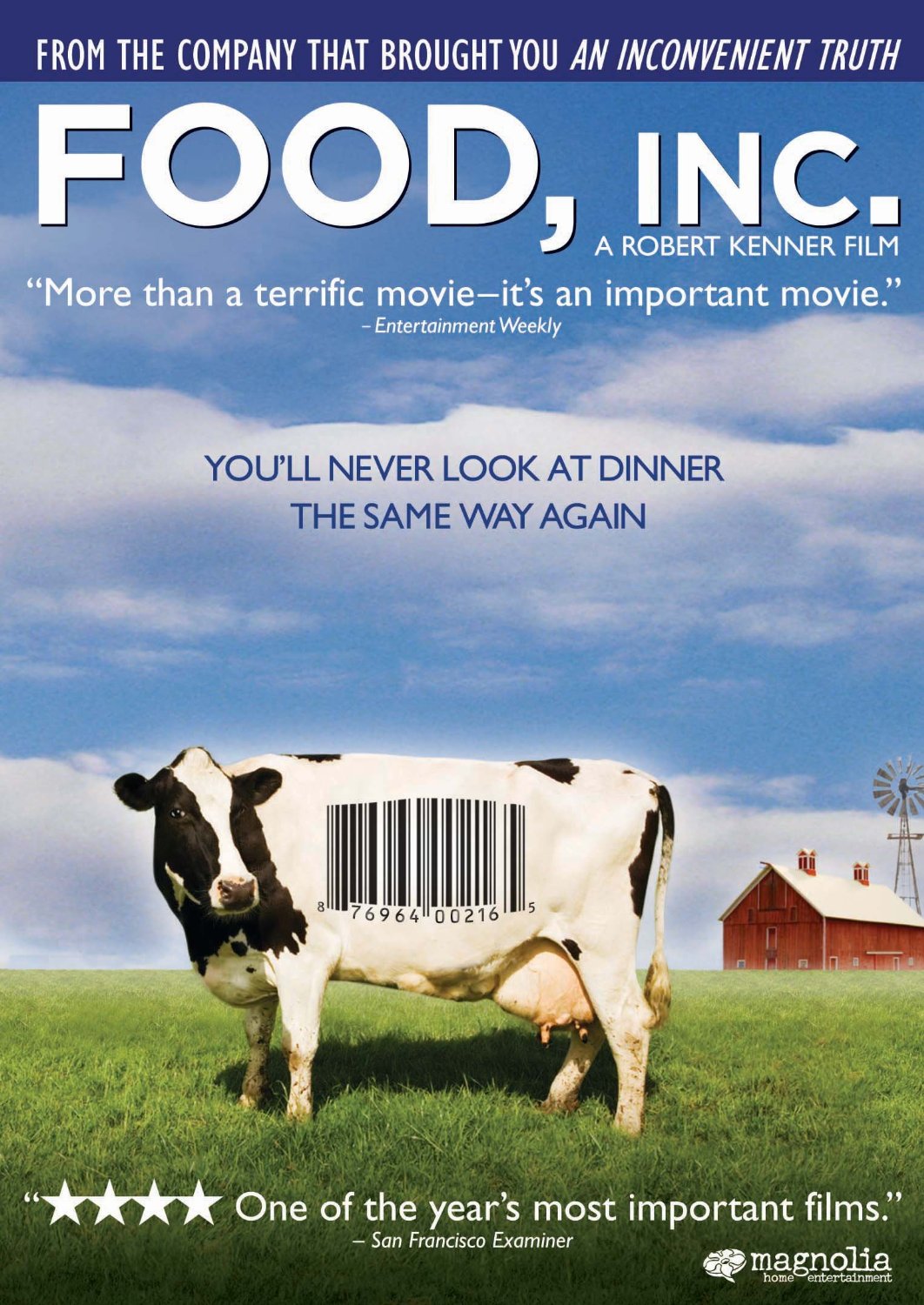
Farmers Markets
Listing of farmers markets around the country. Includes a fact sheet about farmers markets and information about starting your own market. (From the USDA.)
Heritage Foods USA
Promotes genetic diversity, small family farms, and a fully traceable food supply. Committed to making wholesome, delicious and sustainably produced heritage foods available to all Americans. Current focus is on poultry. Fosters the link between sustainable land use, small-scale food production and preservation of the foods of past generations for future generations.
Local Harvest
A guide to online stores, farms, CSA, farmers markets and food co-ops selling all types of sustainably-raised food, including fruits and vegetables, nuts, grains, flowers and herbs. Also has an online store where you can buy products directly from family farms.
The Meatrix rBGH-free Dairy List
Search by state to find milk, butter, yogurt, ice cream and other dairy products that are rBGH-free. Mail order brands are included as well. We’ve also provided them as downloadable lists for your iPod to make shopping easier!
The National CSA Database
The Robyn Van En Center for CSA Resources provides a complete listing of CSAs throughout the US – just punch in your zip code to find a CSA near you!
Pastured Products Directory
State by state listing of pasture-raised animals, including cattle, pigs, poultry and rabbits. There is no independent certification, though producers have stated they follow the Eat Wild criteria, which limits antibiotics, excludes hormones and requires the animals be treated humanely and raised on pasture. (Eat Wild, produced by Jo Robinson)
Pesticides in Produce
A guide to 12 popular fresh fruits and vegetables that are consistently the most contaminated with pesticides and those 12 fruits and vegetables that consistently have low levels of pesticides. (Food News, from the Environmental Working Group)
Seafood Watch
Eating fish has become so confusing. Is it farmed, wild, endangered, or over fished? Are the fishing practices unsustainable? The Monterey Bay Aquarium’s Seafood Watch has information on all types of seafood. Includes a printable wallet card of which fish to buy, be concerned about, and avoid. Currently does not cover health issues surrounding fish. (Informational only – does not give actual places to buy fish.)
Seasense Database
Description of different types of fish followed by important points to be aware of when considering buying or serving it. Lists recommendations from other groups, including Monterey Bay Aquarium, NRDC, Blue Ocean Institute and Environmental Defense. Don’t forget to visit their Subscriber Database, a listing of ocean-friendly restaurants, fish markets and other businesses in some parts of the country. (Seafood Choices Alliance, a partnership of groups around the country working to save our oceans.)
Food and Water Watch’s Fish Guidelines
With 10 easy steps, FWW provides you with the most important things to remember when buying fish.
True Food Shopping List
Find out what foods contain genetically engineered ingredients. The True Food Shopping List contains hundreds of brand name products found in grocery stores around the country, listed into two columns — those that contain GE ingredients and those that don’t. The True Food Guide is a list of fruits and vegetables also separated into GE and non-GE. (True Food Network)
FOOD EDUCATIONAL ORGANIZATIONS AND NONPROFITS
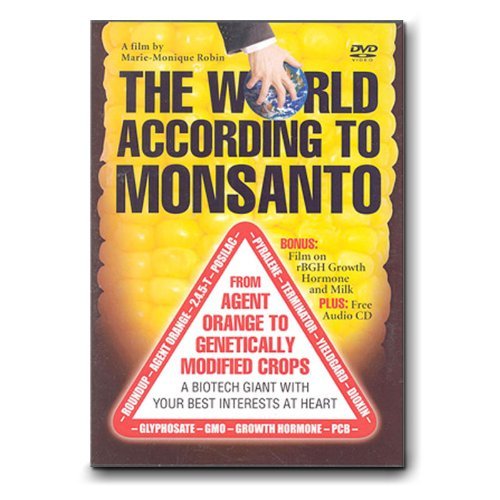
Ecology Action and Grow Bionintensive. Since 1972 we and our colleagues have been researching and developing GROW BIOINTENSIVE®, a high-yielding, sustainable agricultural system that emphasizes local food production and is based historically on intensive gardening systems.
Food Not Lawns. Turning Yards into Gardens and Neighborhoods into Communities. Find or start a local chapter of Food Not Lawns (scroll to the bottom of the website for listings). Read the book.
Institute for Responsible Technology. The Institute for Responsible Technology is a world leader in educating policy makers and the public about genetically modified (GM) foods and crops. We investigate and report their risks and impact on health, environment, the economy, and agriculture, as well as the problems associated with current research, regulation, corporate practices, and reporting. Fantastic number of resources on this website to shop GMO-free, to become active in your community, and to take action on national and global GMO issues!
Local Harvest. The best organic food is what’s grown closest to you. Use our website to find farmers’ markets, family farms, and other sources of sustainably grown food in your area, where you can buy produce, grass-fed meats, and many other goodies. Want to support this great web site? Shop in our catalog for things you can’t find locally!
Organic Consumers Association. The Organic Consumers Association (OCA) is an online and grassroots non-profit 501(c)3 public interest organization campaigning for health, justice, and sustainability. The OCA deals with crucial issues of food safety, industrial agriculture, genetic engineering, children’s health, corporate accountability, Fair Trade, environmental sustainability and other key topics. We are the only organization in the US focused exclusively on promoting the views and interests of the nation’s estimated 50 million organic and socially responsible consumers.
Permaculture Institute. Permaculture is an ecological design system for sustainability in all aspects of human endeavor. It teaches us how build natural homes, grow our own food, restore diminished landscapes and ecosystems, catch rainwater, build communities and much more. The Permaculture Institute is an educational non-profit, offering Permaculture Design Courses and in-depth sustainable living classes.
Weston A. Price Foundation. The Weston A. Price Foundation is a nonprofit, tax-exempt charity founded in 1999 to disseminate the research of nutrition pioneer Dr. Weston Price, whose studies of isolated nonindustrialized peoples established the parameters of human health and determined the optimum characteristics of human diets. Dr. Price’s research demonstrated that humans achieve perfect physical form and perfect health generation after generation only when they consume nutrient-dense whole foods and the vital fat-soluble activators found exclusively in animal fats.
The Foundation is dedicated to restoring nutrient-dense foods to the human diet through education, research and activism. It supports a number of movements that contribute to this objective including accurate nutrition instruction, organic and biodynamic farming, pasture-feeding of livestock, community-supported farms, honest and informative labeling, prepared parenting and nurturing therapies. Specific goals include establishment of universal access to clean, certified raw milk and a ban on the use of soy formula for infants.


